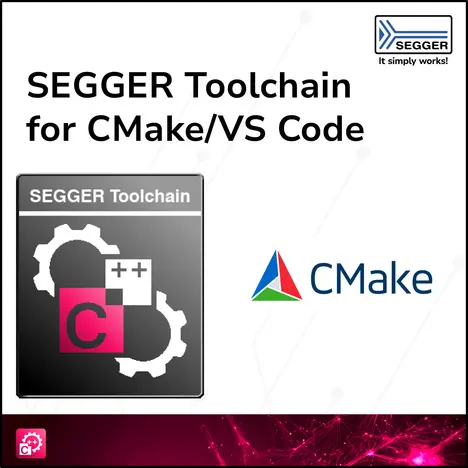- Embedded Studio
- Runtime Library
- Press releases 2025

SEGGER integrates its Toolchain with CMake and VS Code
Increasingly, modern embedded-software projects are designed around developer flexibility. The result is a division of labor in project management, source-code editing, firmware compilation, testing, and debugging. This enables software engineers to ideally match components with projects, as well as to individually select their favorite tools to bundle with a (meta) build system.
The SEGGER Toolchain is ideally suited for such projects, and it is included with the Embedded Studio integrated development environment (IDE) — where it has proven to be particularly effective. The Toolchain consists of the SEGGER Compiler for generating optimized code for Arm and RISC-V microcontrollers; the SEGGER Linker for combining objects into an executable program with ultra-fast speed and flexible section placement; and the SEGGER Runtime Library, which has been written from the ground up for use with embedded devices. Integration of the SEGGER Toolchain with CMake means projects can be developed with VS Code.
CMake is a free, cross-platform, open-source software development tool for building applications via compiler-independent instructions. Existing CMake projects that use GCC or other toolchains can be ported to work with the SEGGER Toolchain with minimal effort. Furthermore, existing Embedded Studio projects can be moved to CMake to enable the use of VS Code, if required.
“It’s extremely easy for CMake users to deploy the SEGGER Toolchain as an alternative to GCC, Clang, or other commercial options,” says Dirk Akemann, Head of Technical Marketing, SEGGER. “Our internal tests show that with the SEGGER Toolchain, programs are significantly smaller than average, typically 5–20%, especially when using linker deduplication and link-time optimization. They also have high execution speeds and show significantly reduced power consumption. For debugging, use of our J-Link probe with Ozone results in a combination that can’t be beaten. Another bonus is that first-class professional support is always available.”
To use the SEGGER Toolchain with CMake, Embedded Studio V8.24 or later is required. A tutorial on using the SEGGER Toolchain with CMake and VS Code, along with guides and examples for setting up new projects, is available here.